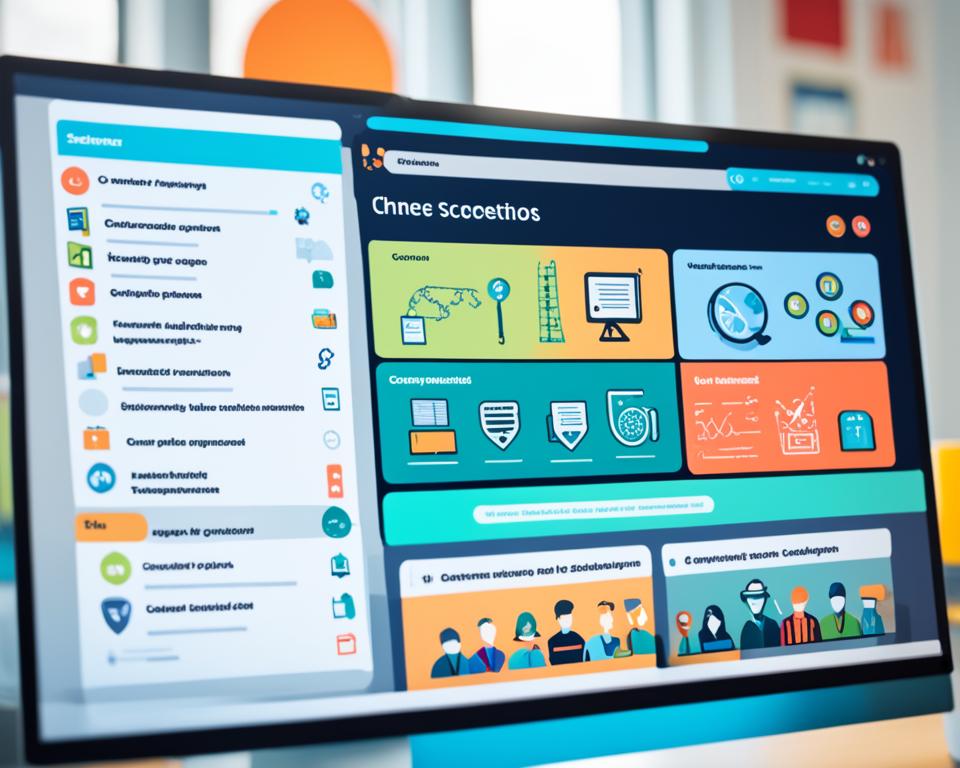The concept of traditional education has transformed with the rise of the internet and new technologies. Online education, also known as distance learning, has become a valid and useful option for many students. In fact, over 30 percent of higher education students in the US are now taking at least one distance course. This shift in educational paradigms comes with numerous benefits, offering flexibility, a wide selection of programs, accessibility from anywhere in the world, a customized learning experience, and cost-effectiveness compared to traditional education.
Key Takeaways:
- Distance learning provides flexibility in balancing work and studies, allowing students to set their own learning pace and schedule.
- It offers a wide selection of programs, including online degrees and certificates, catering to diverse educational needs.
- Distance learning enables learners to study from anywhere in the world, eliminating the need for commuting and expanding travel opportunities.
- It provides a tailored learning experience, with smaller class sizes and interactive learning methods, such as forums and discussions.
- Distance learning tends to be more cost-effective than traditional education, with various payment options, scholarships, and savings on commuting and materials.
The Flexibility of Distance Learning
Distance learning offers a unique level of flexibility in education, allowing you to find the perfect work-study balance while developing essential time management skills and fostering autonomy in learning. With the ability to set your own learning pace and schedule, distance learning empowers you to achieve your educational goals while accommodating your personal and professional commitments.
Whether you are a working professional, a parent, or someone with other responsibilities, distance learning enables you to tailor your education to fit your unique circumstances. By taking control of your learning schedule, you can allocate time for work, family, and personal pursuits without compromising the quality of your education.
When engaging in distance learning, you are not bound by rigid class schedules or limited access to educational resources. Instead, you have the freedom to choose when and where you study, granting you the autonomy to maximize your learning potential. This autonomy allows you to take charge of your education, creating a personalized learning experience that suits your individual learning style and preferences.
Benefits of Flexibility in Education
The flexibility of distance learning provides numerous benefits:
- Work-Study Balance: Distance learning enables you to pursue your studies alongside your work commitments, ensuring a harmonious work-study balance.
- Time Management Skills: By managing your own schedule, you develop valuable time management skills that are highly sought after in today’s fast-paced world.
- Autonomy in Learning: Distance learning fosters independence and self-driven learning, giving you the freedom to explore and delve deeper into subjects that resonate with your interests and career aspirations.
Experience the freedom and flexibility of distance learning, empowering you to achieve your educational goals while maintaining a healthy work-study-life balance.
“Distance learning allows you to take control of your education, providing the flexibility to pursue your studies on your own terms and schedule. This newfound autonomy fosters independence and self-discipline, essential skills that extend beyond the classroom.”
Wide Selection of Programs in Distance Learning
When it comes to distance learning, the options are virtually limitless. The internet has opened up a world of opportunities, allowing universities and higher education schools to offer their programs online. Whether you’re interested in pursuing a degree, earning a certificate, or gaining new skills, there are online programs available to suit your needs.
Universities across the globe now recognize the importance of online education and have adapted their offerings accordingly. Renowned institutions such as Harvard, Stanford, and MIT are just a few examples of universities offering online education. These programs not only provide the same level of quality and expertise as traditional on-campus programs but also offer the flexibility and convenience of online learning.
Whether you’re looking to enhance your professional skills or pursue a new career path, online programs can provide the knowledge and credentials you need. From business and technology to healthcare and the arts, there are online programs available in almost every field of study.
The variety of programs available online ensures that there is something for everyone. Whether you’re a recent high school graduate, a working professional, or a stay-at-home parent, online programs offer the flexibility to fit your lifestyle and schedule.
| Benefits of Online Programs | Examples of Online Programs |
|---|---|
|
|
Obtaining certificates and degrees online has become increasingly popular among students of all backgrounds. Online education provides the opportunity to earn respected credentials without the need to physically attend a university campus. This accessibility is particularly beneficial for individuals who may have geographic, financial, or time constraints that make traditional education impractical.
Whether you’re seeking professional development, career advancement, or personal growth, online programs can provide the education and qualifications you need to succeed. The convenience and flexibility of online learning, combined with the wide selection of programs available, make distance education a viable option for anyone looking to expand their knowledge and skills.
Accessibility of Distance Learning
One of the key advantages of distance learning is the accessibility it offers to students. With online education, you have the freedom to study from anywhere in the world, eliminating the need for commuting to a physical campus. This not only saves you time but also reduces transportation costs and the stress associated with daily travel.
Imagine being able to pursue your education while traveling, whether it’s exploring different countries or residing in a new city. Online courses and virtual classrooms can be accessed as long as you have an internet connection, providing you with the flexibility to study while on the go or even from the comfort of your own home.

By studying remotely, you have the opportunity to experience new cultures, immerse yourself in diverse environments, and make the most of your time and resources. Whether you’re a full-time professional, a parent, or have other commitments, distance learning allows you to integrate education into your life without major disruptions.
Furthermore, the accessibility of distance learning brings about significant cost savings. Without the need for daily commuting, you can eliminate expenses related to transportation, such as fuel, parking fees, and public transportation fares. These savings can be reinvested into your education, personal growth, or other essential needs.
Distance learning truly opens up a world of possibilities, enabling you to study from anywhere, explore new horizons, and make the most of your resources. Embrace the freedom and accessibility that online education offers and embark on a journey of knowledge and personal development.
Customized Learning Experience in Distance Learning
Distance learning offers a personalized learning experience tailored to your individual requirements and level of ability. With the flexibility of online classes, you can expect smaller class sizes, which foster greater interaction and feedback between you, your peers, and your tutors. This personalized approach allows for an enriched learning environment where you can engage in collaborative discussions, receive individualized attention, and actively contribute to the learning process.
One of the key advantages of distance learning is the diverse range of learning materials available to you. Through digital platforms, you have access to a wealth of resources, including videos, photos, eBooks, and interactive presentations. These materials are carefully curated to provide a comprehensive and engaging learning experience, allowing you to explore different formats and mediums that suit your preferred learning style.
Interactive learning methods further enhance the distance learning experience. Online forums and discussions give you the opportunity to interact with your peers, share insights, seek clarification, and learn from different perspectives. This collaborative approach promotes critical thinking, problem-solving, and encourages active participation in your studies. Additionally, online assessments and quizzes provide immediate feedback, enabling you to gauge your progress and identify areas for improvement.
“The customized learning experience in distance learning allows students to pursue their academic goals in a way that suits their unique needs. With smaller class sizes and interactive learning methods, students receive personalized attention and have the opportunity to engage with diverse learning materials. This tailored approach fosters a more engaging and effective learning experience.”
Benefits of a Customized Learning Experience in Distance Learning:
- Personalized attention and feedback from tutors
- Interaction with peers to enhance learning
- Access to diverse learning materials
- Engagement in interactive learning methods
- Opportunity for self-paced learning
By tailoring the learning experience to your specific needs, distance learning empowers you to take control of your education and achieve your goals in a way that aligns with your strengths and preferences.
| Advantages | Disadvantages |
|---|---|
| Personalized attention and feedback | Lack of face-to-face interaction |
| Flexibility in learning pace and schedule | Requires self-discipline and motivation |
| Diverse range of learning materials | Reliance on technology and internet access |
| Opportunity to engage in interactive discussions | Potential for isolation without physical classroom |
Cost-effectiveness of Distance Learning
When it comes to pursuing higher education, affordability is often a concern for many individuals. This is where distance learning truly shines, as it offers a cost-effective alternative to traditional in-person education. Online education tends to be more affordable compared to attending a physical campus.
One of the key advantages of distance learning is the availability of flexible payment options. Many online education providers offer installment plans or per-class payment options, allowing students to manage their expenses more efficiently. This flexibility ensures that education remains accessible to a wider range of individuals, regardless of their financial circumstances.
Furthermore, students pursuing distance learning programs may also be eligible for various discounts and scholarships. These opportunities further reduce the overall cost of education and make it more affordable. By taking advantage of scholarships, students can significantly lessen their financial burden while still obtaining a quality education.
Additionally, distance learning eliminates the need for commuting to a physical campus, which results in significant cost savings. With the rising costs of transportation and commuting expenses, learners can save a substantial amount of money by studying from the comfort of their own homes or any location with an internet connection. Moreover, distance learning eliminates the need to purchase costly textbooks and other class materials, as digital resources are readily available online.
Distance Learning for Teacher Training
Distance learning is revolutionizing teacher training programs, providing educators with the flexibility and resources they need to enhance their skills and knowledge. Whether it’s pursuing advanced degrees, obtaining teaching certifications, or attending professional development workshops, distance education for teachers offers a wide range of online resources and tools to support their growth.
Online Resources for Teacher Training
Distance learning platforms offer a wealth of online resources specifically designed for teacher training. These resources include:
- Webinars and virtual workshops led by experienced educators and experts in the field
- Educational blogs, podcasts, and discussion forums where teachers can exchange ideas and best practices
- Open educational resources (OER) such as textbooks, lesson plans, and multimedia materials
- Online libraries and digital archives for accessing academic journals and research
These resources empower teachers to stay up-to-date with the latest teaching methodologies, insights, and trends in education.
Virtual Classrooms for Collaborative Learning
The availability of virtual classrooms enables teachers from across the globe to connect and collaborate. Through live online sessions, teachers can engage in group discussions, interactive activities, and peer-to-peer feedback. Virtual classrooms also provide a platform for delivering lectures, organizing presentations, and conducting assessments. These dynamic learning environments foster a sense of community and facilitate the exchange of ideas and best practices among educators.
Professional Organizations for Teacher Support
Distance learning for teacher training is further enhanced by professional organizations dedicated to supporting educators. These organizations offer:
- Membership opportunities and networking events to connect teachers with like-minded professionals
- Access to specialized training programs and workshops
- Mentorship programs where experienced educators provide guidance and support
By joining these professional organizations, teachers can tap into a vast network of resources and expertise to enhance their skills and professional growth.
The Impact of Distance Learning on Teacher Training
“Distance learning breaks down geographic barriers, making high-quality teacher training accessible to educators worldwide. It empowers teachers to continuously develop their skills, fostering a culture of lifelong learning and growth.” – John Smith, Education Specialist
| Benefits of Distance Learning for Teacher Training | Challenges of Distance Learning for Teacher Training |
|---|---|
|
|
Despite the challenges, distance learning opens doors for teachers to expand their horizons and grow professionally in an increasingly connected world.
The Advancements in Distance Learning Technology
Distance learning has witnessed remarkable advancements in technology, revolutionizing the educational landscape. These technological innovations have opened up new possibilities for educators and learners, offering enhanced learning experiences and alternative modes of content delivery. In this section, we explore some of the key advancements in distance learning technology.
Audio and Video Tools
The integration of audio and video tools has greatly enriched distance learning experiences. Educational institutions and platforms now utilize audio and video capabilities to deliver engaging lectures, facilitate live discussions, and provide demonstrations and simulations. These tools enable learners to interact with content in a more immersive and dynamic manner, fostering deeper understanding and retention.
Virtual Reality (VR)
Virtual Reality (VR) has emerged as an exciting technology in distance learning. By creating immersive virtual environments, VR enables learners to experience real-life scenarios and simulations, enhancing their understanding and practical skills. From medical training to architecture, VR applications in distance learning have the potential to revolutionize various fields.
Mobile Learning
The proliferation of mobile devices has facilitated the rise of mobile learning in distance education. Mobile learning allows learners to access educational materials on their smartphones or tablets anytime and anywhere. With mobile apps and responsive platforms, learners can engage with interactive content, participate in discussions, and complete assignments on the go.
These technological advancements have significantly transformed the distance learning landscape, making education more accessible, engaging, and interactive. As technology continues to evolve, we can expect further innovations that will shape the future of distance learning.
Distance Learning Management Systems
Distance learning relies on learning management systems (LMS) as the primary platform for delivering online courses. LMSs provide a comprehensive set of tools and features that enable effective course design, instructional frameworks, and evaluation. With the advancement of online platforms, distance learning programs can be created and managed seamlessly, offering a rich and interactive learning experience for students.
Key Features of Learning Management Systems
- Course Design: Learning management systems offer intuitive interfaces and templates that simplify the process of creating engaging online courses. Educators can easily structure their content, incorporate multimedia elements, and design interactive activities to enhance student participation and understanding.
- Instructional Frameworks: LMSs provide a robust framework for organizing and delivering instructional content. Educators can create modules, lessons, or units to guide students through the learning process. The system allows for sequencing of materials, setting learning objectives, and tracking progress.
- Evaluation Tools: LMSs enable educators to assess students’ performance through various evaluation methods. They offer features such as quizzes, assignments, and assessments that can be automatically graded, providing instant feedback to students. This facilitates timely identification of learning gaps and allows for personalized interventions.
Online platforms play a crucial role in the success of distance learning programs. They provide a user-friendly interface, seamless communication tools, and collaborative spaces for students and instructors to interact. These platforms often include features like discussion forums, chat rooms, and video conferencing capabilities, fostering an engaging and collaborative virtual learning environment.
“Learning management systems and online platforms have revolutionized the way education is delivered in the digital age. They provide educators with powerful tools to design and manage distance learning programs effectively, while offering students a flexible and interactive learning experience.”
Having a robust learning management system combined with a comprehensive online platform is essential for successful distance learning programs. These technologies provide educators with the means to deliver high-quality education and engage students in meaningful ways, regardless of their geographical location.
| Learning Management System | Key Features |
|---|---|
| Blackboard Learn |
|
| Canvas |
|
| Moodle |
|
| D2L Brightspace |
|
Benefits of Distance Learning in the Corporate Setting
In today’s fast-paced business world, employee training and development are essential for companies to stay competitive. Distance learning offers valuable benefits in the corporate setting, providing cost-effective and convenient learning solutions that cater to the specific needs of organizations.
Online Training for Enhanced Employee Skills
Distance learning programs empower companies to offer online training courses that focus on the development of specific skills in employees. Whether it’s leadership, project management, customer service, or technical expertise, online training programs provide comprehensive and targeted educational content.
- Equip your employees with the latest industry knowledge and best practices through professionally designed online courses.
- Address skill gaps and enhance employee performance by tailoring the learning experience to meet individual and company needs.
- Keep up with evolving trends and technologies through easily accessible online resources.
Cost-Effective Learning Solutions
Distance learning offers cost-effective learning solutions for companies of all sizes. By utilizing online training programs, organizations can mitigate expenses associated with traditional in-person training methods.
- Save on travel costs, venue rentals, and instructor fees by delivering training materials directly to employees’ devices.
- Eliminate the need for physical training materials and handouts, reducing paper waste and environmental impact.
- Maximize your training budget by reaching a larger audience with scalable online courses.
Convenience and Flexibility
One of the key advantages of distance learning in the corporate setting is its convenience and flexibility. Online training programs allow employees to access educational resources at their own pace and convenience.
- Enable employees to engage in training activities without disrupting their daily work schedules.
- Provide learning opportunities that can be accessed from anywhere, eliminating the need for employees to travel to training locations.
- Offer flexibility in terms of training hours, allowing employees to learn during non-peak work times.
Distance learning programs provide cost-effective and convenient learning solutions that cater to the specific needs of organizations.
Investing in employee development through distance learning not only enhances individual skills and knowledge but also contributes to the overall success of the organization. By embracing cost-effective online learning solutions, companies can stay competitive and adapt to the ever-changing business landscape.
The History of Distance Learning and Its Evolution
Distance learning has a long and fascinating history that traces back to the origins of correspondence courses. Before the internet, educational institutions utilized various means to reach students beyond their immediate areas.
Correspondence courses were one of the earliest forms of distance learning. In the 18th century, students would receive lessons and assignments through the mail, completing work at their own pace and sending it back for assessment. This method allowed for education to be accessible to individuals who couldn’t attend traditional classrooms due to geographical limitations or other circumstances.
With the advent of information technology, distance learning experienced a significant transformation. The rise of the internet and digital platforms provided new avenues for educational delivery, giving birth to the evolution of online education.
Universities and educational institutions around the globe recognized the potential of distance learning and leveraged it to expand their reach. They began offering online programs and courses, allowing students to access higher education regardless of their location.
Today, online education has become an integral part of the educational landscape, providing individuals with the opportunity to learn and acquire new skills irrespective of geographical boundaries.

Conclusion
Distance learning is revolutionizing the way we learn and shaping the future of education. With its numerous benefits and global accessibility, it has become more than just a trend. One of the key advantages of distance learning is the ability to provide high-quality education to learners all around the world. Regardless of geographical location, students can access top-notch courses and programs from renowned institutions.
Another significant benefit of distance learning is the personalized learning experience it offers. Through online platforms and interactive methods, students can tailor their education to suit their individual needs and learning styles. This customized approach fosters better engagement, knowledge retention, and overall academic success.
The global accessibility of distance learning is a game-changer in education. No longer bound by physical barriers, learners can access educational opportunities without the need to relocate or travel long distances. This opens up a world of possibilities and allows individuals to pursue their educational goals while maintaining their personal and professional commitments.
As technology continues to advance, distance learning will continue to evolve and adapt, providing even more innovative and effective learning solutions. The future of learning is undoubtedly intertwined with distance education, offering endless possibilities for students and educators alike.
FAQ
What is distance learning?
Distance learning is a mode of education that allows students to learn remotely, often through online platforms or virtual classrooms. It provides flexibility in terms of setting the learning pace and schedule while offering access to a wide range of programs and courses.
How does distance learning offer flexibility?
Distance learning allows students and teachers to set their own learning pace and schedule, providing flexibility in balancing work and studies. It teaches important time management skills and promotes autonomy in learning.
What programs are available in distance learning?
Many universities and higher education schools now offer online versions of their programs, providing options for every type of student. Online learning is a great way to obtain official certificates, diplomas, or degrees without physically attending a university campus.
Can I study from anywhere in the world with distance learning?
Yes, distance learning allows learners to study from anywhere in the world without the need for commuting. The virtual classroom can be accessed as long as there is an internet connection, providing opportunities for studying while traveling or living abroad.
How is the learning experience personalized in distance learning?
Distance learning offers a personalized learning experience tailored to each student’s requirements and level of ability. Online classes tend to have smaller class sizes, allowing for greater interaction and feedback between students and tutors. Diverse learning materials such as videos, photos, and eBooks are available, and interactive learning methods like forums and discussions enhance the learning experience.
Is distance learning more affordable compared to in-person education?
Yes, distance learning tends to be more affordable compared to in-person education. There are often payment options available, including installment plans or per-class payments. Many students are eligible for discounts or scholarships, further reducing the cost. Additionally, distance learning saves money on commuting and class materials.
How does distance learning benefit teachers?
Distance learning plays a crucial role in teacher training programs. It offers online resources, tools, and organizations dedicated to supporting teachers in their professional development. The availability of online courses and virtual classrooms allows teachers to enhance their skills and knowledge.
What technologies are used in distance learning?
Distance learning has seen significant advancements in technology. Various tools are used, such as audio and video capabilities, virtual reality, and mobile learning. These technologies enhance the learning experience and provide alternative methods for delivering educational content.
What is the role of learning management systems in distance learning?
Distance learning relies on learning management systems (LMS) as the primary platform for delivering online courses. LMSs provide tools for course design, instructional frameworks, and evaluation. Online platforms offer various features to create and manage successful distance learning programs.
How is distance learning beneficial in the corporate setting?
Distance learning is valuable in the corporate setting for employee training and development. Online training programs cater to specific target groups, helping employees acquire new skills and knowledge. It offers cost-effective and convenient learning solutions for companies.
What is the history of distance learning?
Distance learning has a long history, beginning with correspondence courses delivered via postcards. It has evolved over time with the advancements in information technology. Universities expanded their reach through distance learning to offer education to students beyond their immediate areas.
What does the future hold for distance learning?
Distance learning is not just a trend but the future of learning. It provides high-quality education, personalized learning experiences, and increased accessibility. As technology continues to advance, distance learning will play a crucial role in shaping the future of education worldwide.





